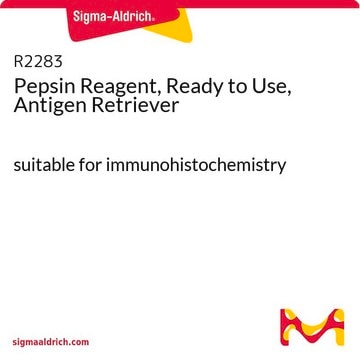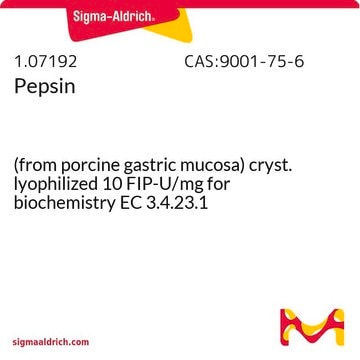Kluczowe dokumenty
P6887
Pepsin from porcine gastric mucosa
lyophilized powder, ≥3,200 units/mg protein
Synonim(y):
Pepsin A, Pepsin from hog stomach
Wybierz wielkość
383,00 zł
Wybierz wielkość
About This Item
383,00 zł
Polecane produkty
pochodzenie biologiczne
Porcine gastric mucosa
Poziom jakości
klasa czystości
Proteomics Grade
Formularz
lyophilized powder
aktywność właściwa
≥3,200 units/mg protein
masa cząsteczkowa
35 kDa
zanieczyszczenia
salt, essentially free
kolor
white to off-white
rozpuszczalność
deionized water: soluble 10 mg/mL
10 mM HCl: soluble 4.0 mg/mL (Cold)
numer dostępu UniProt
Zastosowanie
diagnostic assay manufacturing
Warunki transportu
wet ice
temp. przechowywania
−20°C
informacje o genach
pig ... LOC396892(396892)
Szukasz podobnych produktów? Odwiedź Przewodnik dotyczący porównywania produktów
Zastosowanie
Działania biochem./fizjol.
Definicja jednostki
Komentarz do analizy
Inne uwagi
Inhibitor
Hasło ostrzegawcze
Danger
Zwroty wskazujące rodzaj zagrożenia
Zwroty wskazujące środki ostrożności
Klasyfikacja zagrożeń
Eye Irrit. 2 - Resp. Sens. 1 - Skin Irrit. 2 - STOT SE 3
Organy docelowe
Respiratory system
Kod klasy składowania
11 - Combustible Solids
Klasa zagrożenia wodnego (WGK)
WGK 1
Temperatura zapłonu (°F)
Not applicable
Temperatura zapłonu (°C)
Not applicable
Środki ochrony indywidualnej
dust mask type N95 (US), Eyeshields, Faceshields, Gloves
Wybierz jedną z najnowszych wersji:
Certyfikaty analizy (CoA)
Nie widzisz odpowiedniej wersji?
Jeśli potrzebujesz konkretnej wersji, możesz wyszukać konkretny certyfikat według numeru partii lub serii.
Masz już ten produkt?
Dokumenty związane z niedawno zakupionymi produktami zostały zamieszczone w Bibliotece dokumentów.
Klienci oglądali również te produkty
Produkty
Antibody fragmentation with our pepsin digestion protocol for IgG antibody fragmentation and preparation of F(ab’).
Available Fluorescent in situ hybridization (FISH) procedures, reagents and equipment.
Dostępne procedury, odczynniki i sprzęt do fluorescencyjnej hybrydyzacji in situ (FISH).
Protokoły
This procedure may be used for determination of Pepsin activity using hemoglobin as the substrate. It is a spectrophotometric stop rate determination.
Active Filters
Nasz zespół naukowców ma doświadczenie we wszystkich obszarach badań, w tym w naukach przyrodniczych, materiałoznawstwie, syntezie chemicznej, chromatografii, analityce i wielu innych dziedzinach.
Skontaktuj się z zespołem ds. pomocy technicznej











